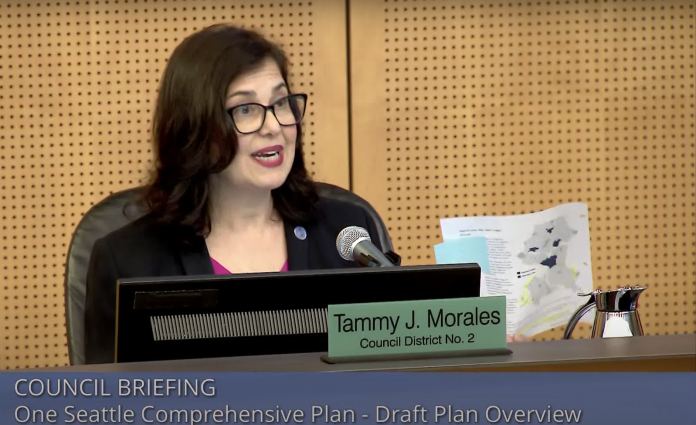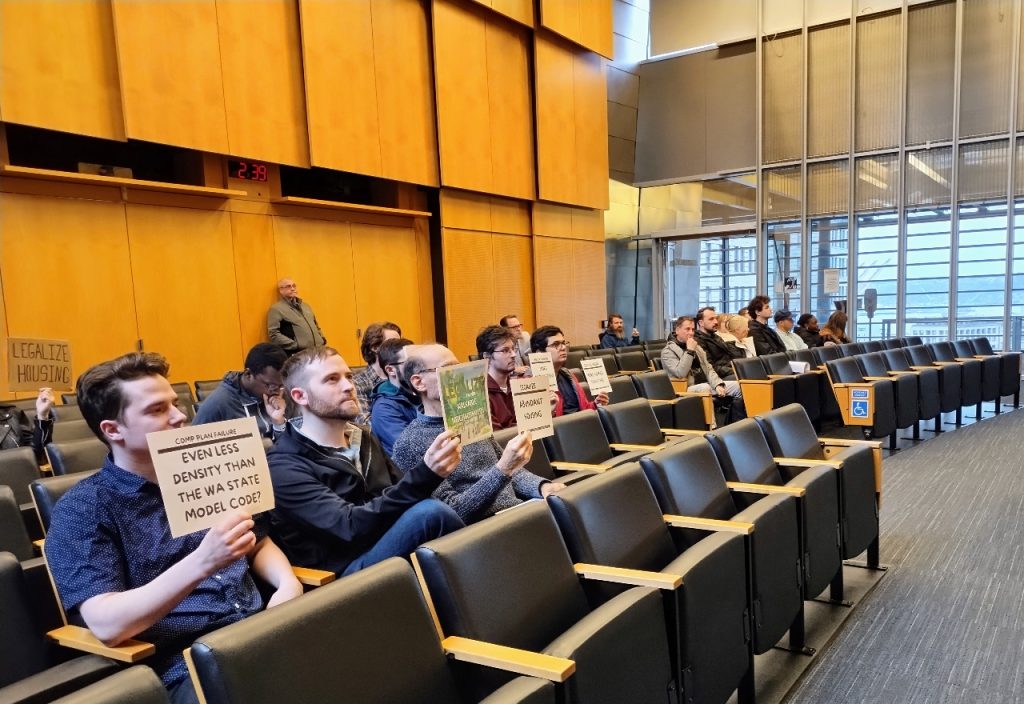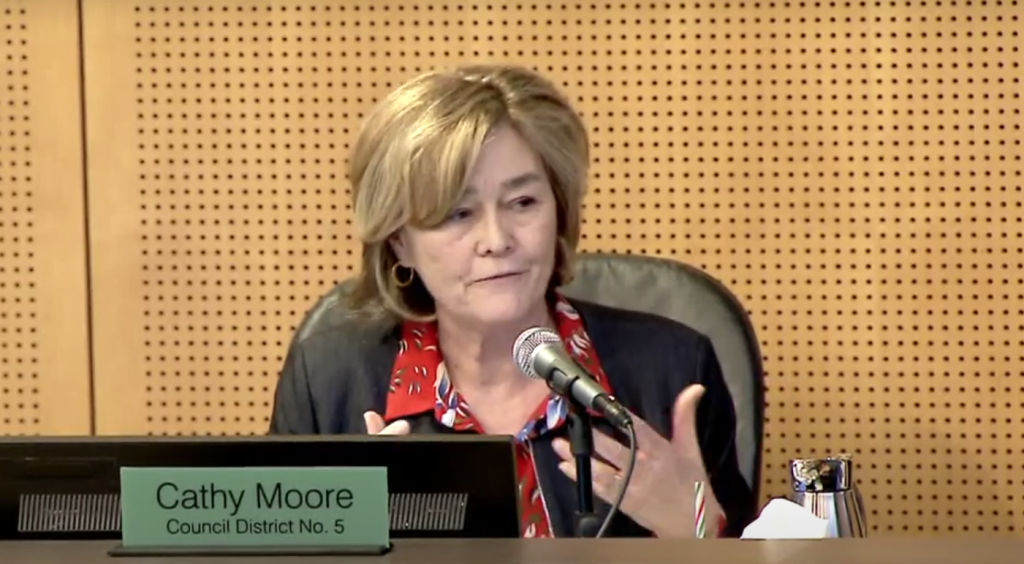
The Seattle City Council got its first look early this week at the 20-year strategy for housing and jobs growth that Mayor Bruce Harrell has put forward as part of his One Seattle Comprehensive Plan update. And while several councilmembers offered hints about what areas they’d like to focus on when the council as a whole gets a chance to review and ultimately approve the plan, District 2 councilmember and land use committee chair Tammy Morales made it clear that she thinks the plan is far from sufficient to meet the challenges facing the city today and will take significant revising to get right.
“My biggest takeaway is that this plan feels like it’s planning for our current conditions, and not planning for a vision of what we know is coming in terms of growth and what we could become, which is a city of really healthy, vibrant well-connected neighborhoods,” Morales said at a briefing Monday on the One Seattle plan.
The plan, released last week, is already drawing criticism from housing advocates who worry it won’t accommodate enough growth to keep housing prices from escalating, and state legislators who have questions about whether it even fully complies with recent state legislation mandating additional allowed density in neighborhoods across the state.
Mayor Harrell’s office, represented at Monday’s meeting by deputy director of policy Christa Valles, pushed back on criticism of the plan’s ambitions by emphasizing that the 100,000 additional units that the city expects to see in the next 20 years — only around 20,000 more than current baseline projections (and the minimum number assigned by the county) — are not the same as the additional zoning capacity created by the plan, even as the City still hasn’t released a firm number on what that additional capacity actually translates to. Valles touted the city’s rapid growth over the past decade-and-a-half, suggesting the city’s path to success is largely the same one that has been seen.

“Since our Comp Plan was adopted in 2015, we have added 70,000 homes, meeting our current 20-year growth target in just eight years,” Valles said. “This statistic also illustrates that growth targets are not the same thing as zoning capacity. Even today, with this rapid expansion of housing in Seattle in recent years, our current zoned capacity for new housing stands at 165,000 units. This does not include our current proposed plan and the additional capacity that will be added with it.”
But Morales didn’t mince words when it came to how she sees the plan as maintaining the status quo. She took aim in particular at a lack of expansion plans for the city’s regional centers — currently central Seattle neighborhoods like Uptown, Downtown, and First Hill/Capitol Hill, as well as Northgate and the U District — do not include the south half of the city. Regional centers are areas that traditionally see the most housing and jobs growth, and are designated in conjunction with the Puget Sound Regional Council (PSRC), which generally requires a neighborhood level plan separate from a city’s Comprehensive Plan to guide growth in those areas.

“What we’re doing here is continuing the status quo,” Morales said. “We’re excluding the South End from intentionally planning for economic development opportunities. We’re doing ourselves to the same mistakes we made in the past and creating deeper economic inequality. This area was already identified as an area of low access to economic opportunity in the last comprehensive plan.”
But whether Morales will have any true allies on the council when it comes to radically changing the plan remains unclear.
“The goal is to increase the supply and diversity of housing options,” District 5’s Cathy Moore said Monday. Last year, Moore told The Urbanist that she supported Alternative 5, and even supported studying an Alternative 6 that would have gone even further. The current plan falls well short of even Alternative 5 even as it picks and chooses elements from the other options.

But Moore suggested one of the primary concerns she was hearing from constituents had more to do with aesthetics than anything else. “The feedback that I get from District 5, from homeowners, is that [current development is] just too townhouse-specific and too townhouse-centric, and that people are really looking and [are] much more receptive to a sense of a housing diversity.”
More likely to end up in the mayor’s corner are councilmembers like Bob Kettle (District 7), Rob Saka (District 1), and Maritza Rivera (District 4). Last year, Rivera told The Urbanist that her vision for a growth strategy was roughly in line with what Harrell has proposed now. “If we allowed development up to quad-plexes everywhere in the City while expanding transit-oriented development, we would address a very significant portion of our housing affordability crisis and preserve the unique character of our neighborhoods,” Rivera said last summer.
Saka, who told The Urbanist last year that he supports “increasing the most density along transit corridors and in urban villages,” also suggested that the city should be careful about going too far Monday.
“I strongly support thoughtful growth,” Saka said this week, suggesting that neighborhoods needed to have infrastructure like grocery stores in place before they could be asked to take on more density. “If not, this whole 15-minute walkable neighborhood is a pipe dream, for many, unless and until we get a lot of that really important nitty-gritty, last-minute, last-mile details,” he said.
With most of the council focused on immediate issues like police hiring or immediate budget issues, Morales seems to be the one urging the council to consider the long-term implications of the decisions that get made this year and into next year around the Seattle Comprehensive Plan.
“This plan is about the future of Seattle’s housing and jobs and our climate strategies,” Morales said. “We have a once in a decade chance to build more affordable housing, to decrease rents, to create economic opportunity and bring good jobs to folks across the city, particularly to underserved communities, and to build a smarter, more efficient city that is serious about addressing our climate emergency.”
The draft plan is open for public comments until mid-May, via the online engagement hub or by emailing oneseattlecompplan@seattle.gov. The first in-person open house to provide feedback on the plan is this Thursday, March 14, at Loyal Heights Community Center, from 6-7:30pm. One open house is being hosted in every district, followed by a citywide virtual meeting on May 2.
Ryan Packer has been writing for The Urbanist since 2015, and currently reports full-time as Contributing Editor. Their beats are transportation, land use, public space, traffic safety, and obscure community meetings. Packer has also reported for other regional outlets including BikePortland, Seattle Met, and PubliCola. They live in the Capitol Hill neighborhood of Seattle.

